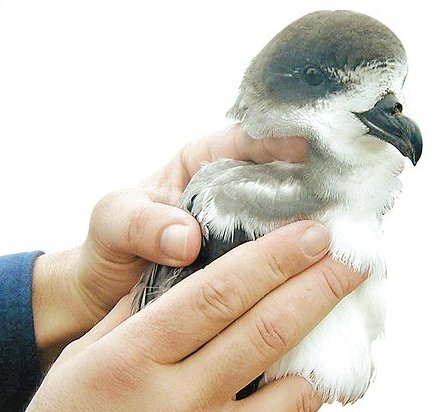- Bermuda Petrel
Taxobox
name = Bermuda Petrel (Cahow)
status = EN | status_system = IUCN3.1
trend = up

image_width = 200px
regnum =Animal ia
phylum = Chordata
classis = Aves
ordo =Procellariiformes
familia =Procellariidae
genus = "Pterodroma "
species = "P. cahow"
binomial = "Pterodroma cahow"
binomial_authority = (Nichols & Mowbray, 1916) The Bermuda Petrel, "Pterodroma cahow", is a gadflypetrel .Commonly known in
Bermuda as the Cahow, a name derived from its eerie cries, thisnocturnal ground-nestingseabird is the national bird of Bermuda, and a symbol of hope fornature conservation. It was thoughtextinct for 330 years. Its dramatic rediscovery as a "Lazarus species", that is, a species found to be alive after being considered extinct for centuries, has inspired documentaryfilmmakers .Initially superabundant throughout the
archipelago , the Cahow is a slow breeder, but excellent flier, and spends itsadult life on the opensea s. At five years old it returns to its former nesting place and begins breeding, laying only one egg per season. Cahows mate for life.The Cahows' eerie
nocturnal cries stopped the early Spanish seafarers settling the Islands out of superstition, as they thought the Isles were inhabited by Devils. Instead they put ashore hogs as a living foodstore for passing ships, and so began the onslaught on the Cahow's existence. Following Bermuda's colonisation by the English, introduced species likerats ,cats anddogs , and mass killings of thebirds by early colonists decimated numbers. Despite being protected by one of the world's earliest conservation decrees, the Governor's proclamation "against the spoyle and havocke of the Cohowes," the birds were thought to have been driven toextinction since the 1620s.In
1951 , 18 surviving nesting pairs were found on rockyislets in Castle Harbour, and a program was set up byDavid B. Wingate to build concreteburrow s and wooden bafflers for the nestingtunnel s in order to keep out the slightly larger, competing 'Bermuda longtail', and to restore the nearby Nonsuch Island to be a future viable base for thespecies .Enjoying legal protection, the species has started to make a good recovery, The main threat for the future is lack of suitable breeding habitat.
Hurricane Fabian destroyed many nesting burrows in2003 , and recently the larger and ecologically-restored Nonsuch Island is being repopulated with chicks, their translocation timed so they will imprint on these surroundings. [http://www.birdlife.org/news/news/2008/03/Bermuda_Petrel.html] This work is being undertaken by the present Bermuda Conservation OfficerJeremy Madeiros assisted by theAustralian petrel specialist Nick Carlile. Nonetheless, the global population of this bird in2005 was only about 250 individuals.References
* Database entry includes justification for why this species is endangered
External links
*ARKive - [http://www.arkive.org/species/GES/birds/Pterodroma_cahow/ images and movies of the Bermuda petrel "(Pterodroma cahow)"]
* [http://www.birdlife.org/datazone/species/index.html?action=SpcHTMDetails.asp&sid=3910&m=0 BirdLife Species Factsheet]
** [http://www.birdlife.org/news/news/2005/09/cahow.html BirdLife: "Cahows bounce back as Bermudians build burrows"]
** [http://www.birdlife.org/news/news/2004/07/cahow_translocation.html BirdLife: "New island home for Cahow chicks"]
** [http://www.birdlife.org/news/news/2006/03/cahow.html BirdLife: "Cahow class of 2002 return to breed"]
** [http://www.birdlife.org/news/news/2008/03/Bermuda_Petrel.html BirdLife: "Bermuda Petrel returns to Nonsuch Island (Bermuda) after 400 years"]
* [http://memory.loc.gov/cgi-bin/query/r?ammem/lhbcb:@field(DOCID+@lit(lhbcb0262adiv23)) Library of Congress early written records]
* [http://www.strangeark.com/bfr/archive/historical/New-Light-Cahow.pdf "NEW LIGHT ON THE CAHOW, PTERODROMA CAHOW" Report on the Cahow rediscovery in 1951]
* [http://www.rarebirdfilm.com Lucinda Spurling's documentary film website]
* [http://www.youtube.com/watch?v=hR5_CMTMac8 sample fromLucinda Spurling 's film Rare Bird, on YouTube]
Wikimedia Foundation. 2010.
